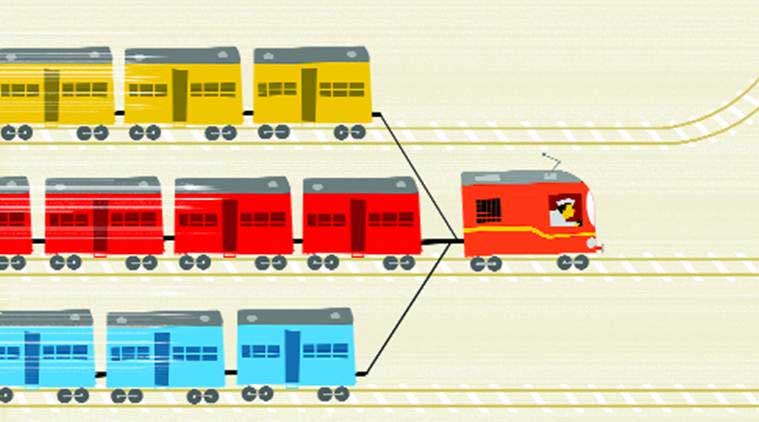Currently, Railways gives 14-16 hours of sleep to its drivers, called “headquarters rest”. Maintaining “running rooms” where loco pilots can sleep is a major priority area in railway administration.
Written by Avishek G Dastidar | New Delhi | Published: December 1, 2017  As a first step, the Kharagpur division of South Eastern Railway has decided to try out the two systems. (Illustration: C R Sasikumar)
As a first step, the Kharagpur division of South Eastern Railway has decided to try out the two systems. (Illustration: C R Sasikumar)
 As a first step, the Kharagpur division of South Eastern Railway has decided to try out the two systems. (Illustration: C R Sasikumar)
As a first step, the Kharagpur division of South Eastern Railway has decided to try out the two systems. (Illustration: C R Sasikumar)
A “VIDEO game” for train drivers to check if they are fit to drive before they are assigned duty, and a special software that sends signals if a driver is sleepy while on the wheel. These are two solutions from the Indian Institute of Technology, Kharagpur, that the Indian Railways has decided to test to address a longstanding problem — sleepy drivers.
As a first step, the Kharagpur division of South Eastern Railway has decided to try out the two systems. “The driver attention system designed at IIT-Kharagpur, planned for pilot study at our division, is technologically and psychosomatically designed to highwire the loco pilots,” K R K Reddy, Divisional Railway Manager, Kharagpur, told The Indian Express.
Named ‘Walopi’ (Warning Loco Pilots) and ‘Chemvist’ (Check My Vigilance State), the two technologies, which have been patented by IIT-Kharagpur Professor Aurobinda Routray and his team in the Electrical Engineering department, will now be developed for Indian Railways. The team gave a detailed demonstration to the Kharagpur division of South Eastern Railway last week.
“We are impressed by the technology. Let’s see if it is as useful as it’s billed to be. We have asked for five prototypes,” confirmed a senior official of the Kharagpur division.
“Globally, driver drowsiness is a major problem and identified as a cause of accidents. The usual test to check whether a person is under the influence of alcohol is common. What our system does is scientifically test if the driver will remain alert enough to drive,” said Routray.
The twin objective is to prevent a driver from being assigned duty if he is likely to become drowsy, and to alert the operations system, including the control centre, if he falls asleep while driving.
Both the technologies are based on what is globally called PERCLOS, or percentage of eyelid closure over the pupil over time, and reflects slow eyelid closures (“droops”) rather than blinks. Globally, the PERCLOS drowsiness metric has been in vogue since the mid-1990s to develop various tools to battle industrial fatigue.
‘Chemvist’ uses Electrooculography (EOG) signals, which essentially give the voltage difference between the cornea and retina of the eye. Drivers will have to wear a specially-designed headband to play a “video game” on a screen. The headband will detect if the driver is fatigued or will be alert for the next few hours.
Research scholars on Routray’s team have reportedly tested this in vehicles. “Railways has shown interest and has asked us to design a few prototypes which they can use and see. It’s an opportunity,” said Routray.
‘Walopi’, on the other hand, checks the on-board level of alertness. It uses a camera with face-detection technology, which assesses if the driver is falling asleep. Equipped with night vision, the camera will continuously screen the driver’s facial information and, if anything is out of line, will send alert signals to everyone concerned.
In the past, loco pilots have been at loggerheads with the administration over the amount of rest they get between their duties. Signal Passed at Danger (SPAD) — the term used when drivers jump signal due to lack of alertness — is a codified offence, for which drivers can even be removed from service. On an average, there are about 40 such cases every year.
According to a 2013 report of a high-powered committee “to review the duty hours of running and other safety-related categories of staff”, lack of sleep was identified as one of the major causes of stress among loco pilots.
Currently, Railways gives 14-16 hours of sleep to its drivers, called “headquarters rest”. Maintaining “running rooms” where loco pilots can sleep is a major priority area in railway administration.
At present, many train engine cabins, mainly the diesel ones, are fitted with what is called a Vigilance Control Device, which comes with a button that the driver has to press at regular intervals during the run. If the driver fails to press the button, the engine is designed to apply the brakes automatically. But that does not help in detecting realtime alertness and fatigue.



.jpg)
.jpg)



0 comments:
Post a Comment